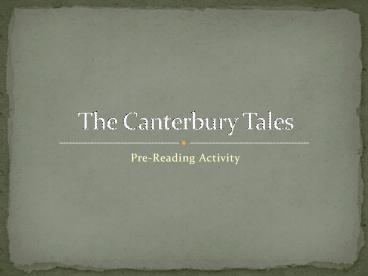Pre-Reading Activity PowerPoint PPT Presentation
1 / 21
Title: Pre-Reading Activity
1
The Canterbury Tales
- Pre-Reading Activity
2
The Middle Ages span what years?
- Approximately 500-1500
- Early Middle Ages 500-1000
- High Middle Ages 1000-1250
- Late Middle Ages 1250-1500
3
What event began theNorman Conquest?
- Sept 28, 1066
- Invasion of England by William the Conqueror
- Battle of Hastings
- Oct 14 1066
4
Who was William the Conqueror?
- Duke of Normandy
- First Norman King of England
5
What culture survived under the Normans? Why?
What impact did this have?
- Anglo Saxon Culture
- Majority of the population
- Many nobles fled to Scotland and other areas
- Christian/Religious Influence
- Impact on language
- Onset of/increase in feudalism
6
What is feudalism?
- Political and social system
- Based on granting of land in exchange for
loyalty, military assistance, and other services - Developed as a result of frequent invasions
- System of social behavior
- Three social classes
- Those who fight
- Those who pray
- Those who work
7
When did the feudal structure break down?
- Began to breakdown due to the Black Death
- Wiped out 1/3 population in England
- 1348-1349
8
Describe the life, ideals, and morals of a knight.
- Primary duty of the male above the serf class was
a military obligation to the King. - Based in the feudal idea of loyalty and related
to a system of social codes - chivalry
- Breaking a code would undermine the knights
position
9
What was a womans place in the feudal system?
- Peasant woman
- childbearing
- Housework
- Hard field work
- Women of higher station
- Household supervision
- Childbearing
- A woman was always subservient to a male, whether
husband, father, or brother. - No political rights
- Depending on the standing of her father or
husband she commanded a certain respect,
especially under the chivalric system of the 11th
and 12th centuries.
10
What is chivalry?
- System of ideals and behavior codes that governed
both knight and gentlewoman. - Loyalty to overlord
- Honesty
- Fairness in battle
- Proper treatment of women
11
What is courtly love?
- Behavior between knights and ladies
- Often between a knight and a married woman
- Usually unconsummated
- Revering and acting in the name of a lady
- Wears colors of lady in battle
- Glorify her in words and be inspired by her
12
What would eventually render the feudal system
obsolete?
- Decrease in population
- People living in towns and cities would
eventually render feudal system obsolete. - Development of lower, middle, and upper class
(evident in Canterbury Tales)
13
What were the crusades?
- A series of wars in the 11th, 12th, and 13th
centuries by Christian Europe against the
followers of Muhammad with Jerusalem and the Holy
Land as the prize. - Began in 1096
14
How did they impact medieval life?
- Europeans failed to hold Jerusalem, but they
benefited from the contact with the higher
civilization of the Middle East. - Mathematics
- Astronomy
- Architecture
- Crafts
15
Who is Thomas Becket? Discuss his relationship to
Henry II.
- Archbishop of Canterbury
- Close friend and appointee of King Henry II
- Becket ignored Henrys wishes to allow Royal
Courts to punish people convicted in Church Court - Four knights under Henry II assassinated Becket
16
Why was Thomas Becket important in the Middle
Ages?
- He was murdered at Canterbury Cathedral
- He was sainted and martyred
- The site of his death became a popular place for
pilgrimages
17
Describe the state of the Church during Chaucers
Middle Ages.
- Church dominated life
- All people believed in heaven and Hell
- Could only get to heaven through the Roman
Catholic Church - People paid tithe (church tax) to church
- Church was wealthy and powerful
18
What is the Magna Carta? What historical impact
did it have?
- The Great Charter of the Liberties of England
- Signed in 1215
- Became the basis for English constitutional law
in which trial by jury and legislative taxation
were established - First document imposed upon a King of England by
his subjects - Attempt to limit his power
- Protect their rights
19
When was the Hundred Years War? Who fought in
it? Why is it important?
- Fought by England and France
- Lasted 116 years 1337-1453
- Development of Yeomen (use of longbow and arrows)
- End of knights and castles as significant
military power - Two kingdoms at the beginning of the war two
nations at the end of it. - Modern democratic England was born
20
How did the bubonic plague help bring about an
end to feudalism?
- 1348-1349
- Spread by fleas from infected rates
- Plague reduced the nations population by one
third - Labor shortage freedom of serfs (last support
of feudalism)
21
- The End

